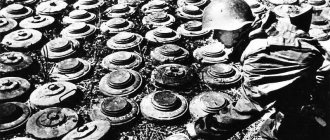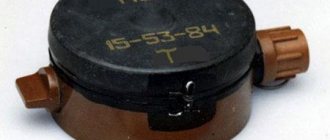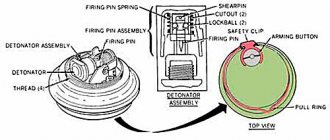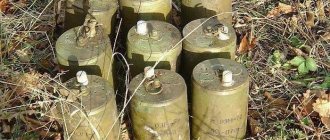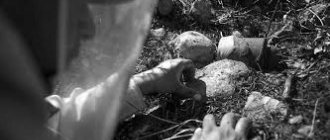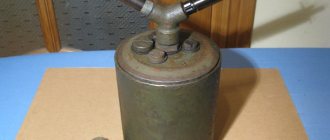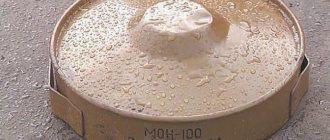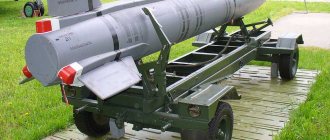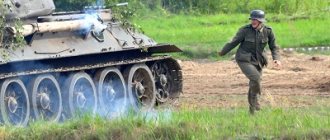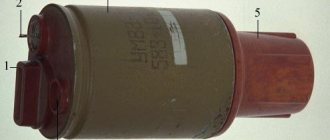Pressure-action anti-personnel mine PMD-6
Type - high explosive, weight - 460-500 g, explosive weight (TNT) - 200 g, dimensions - 190 x 90 x 45 mm, MUV fuse with a T-shaped pin, trigger force - 1-12 kgf. PMD-b is one of the most common anti-personnel mines used by the Red Army during the war. The mine is very technologically advanced; its wooden box can be made even in front-line conditions. PMD-6 had a small actuation force, which made it very sensitive and at the same time dangerous when installed. The PMD-bM, which appeared later, was partially devoid of this drawback - a metal plate was placed between its top cover and the fuse body, increasing the actuation force to 6-28 kgf. The mine had a small number of metal parts, which makes it difficult for a metal detector to detect it. Mines similar in design, but more complex to manufacture and more powerful in action, were used by the Germans from the middle of the war (R-Mt-43).
Options [edit]
Yugoslav variant of the PMR-2A
POMZ anti-personnel mine, Balkans, 1996. Note that this mine was mined using a hand grenade.
These simple design mines were widely copied, including custom examples from unofficial partisan workshops. Some serial copies:
- Type 59
, People's Republic of China (POMZ-2) - MAP
and
Model 15
(copies of POMZ-2 and POMZ-2M) - PMR-1
and
PMR-2A
, Yugoslavia - PP Mi-SK
, Czechoslovakia (POMZ-2, used with RO-1 fuze) - MM-1
, Myanmar (POMZ-2) - MBV-78A1
, Vietnam (POMZ-2) - PMFH-1
,
PMFH-2
, Cuba (POMZ-2 copies)
Anti-personnel fragmentation barrage mine POMZ-2
Weight - 1.5 kg, explosive mass (TNT drilling block) - 75 g, body diameter - 60 mm, height - 130 mm, MUV fuse with P-shaped pin and MD-2 fuse, continuous damage radius 4 m. Dangerous distance up to 60 m.
POMZ-2 is often found both as part of minefields and alone on trails. Captured POMZ-2s were used by the Germans in barrages. The cast iron body of the mine has a notch on the outer surface to ensure uniform crushing, inside there is a cavity for placing an explosive charge (drill block) and installation on a peg driven into the ground. At the top end there is a hole for the fuse. The POMZ-2M mine has a threaded fuse connection. It is possible to install German fuses with the same thread. The mines were installed with one or two guy wires with a total length of no more than 8 m perpendicular to the probable path of the enemy’s advance. Sometimes they were tied to the stakes of the wire fence, to trees. Currently they do not pose a particular danger, because pegs, guy wires and mainsprings are usually rotten. Mines with misfires are especially dangerous - the fuse rod is in the lower position.
POMZ-2M had a weight of 1.2 kg and a length of 107 mm. Homemade POMZ-2 mines were also made from cans, pipe scraps, wooden or metal boxes, into which a TNT block weighing 75 or 200 g was placed, and the free space was filled with pieces of metal. The POMZ-37 mine was made from the casings of 37 mm artillery mines that were no longer in production. Mines similar in design to POMZ-2, but with a smooth body, were used by the Germans since 1942. ZuZ-42 and ZuZ-35, Stockmine (Sto. Mi). Dangerous at a distance of up to 60 m, had double tripwires up to 30 m, T- shaped - up to 15 m.
Description[edit]
Mines consist of a small explosive charge of TNT inside a hollow cylindrical fragmentation cartridge made of cast iron. The bushing has large pieces molded on the outside and is open at the bottom to accept the insertion of a wood or plastic mounting rod. At the top is a weather cover, covering a standardized fuze well that is usually armed with an MUV or VPF tension fuze. The stretcher can be set to detonate on either pressure release or depressurization.
The PomZ-2M has a threaded fuze tube, while the earlier POMZ-2 was threadless, and the fuze and igniter would sometimes fall out if the mine was disturbed. POMZ-2 has 6 rows of rectangular pre-formed pieces, while POMZ-2M has 5 rows and is slightly shorter.
The coarse fragmentation shell produces an uneven fragmentation effect. The effective radius of a mine is often quoted as four meters at 360 degrees, but a small amount of large fragments can be lethal at ranges much greater than this.
Wooden stakes tend to rot in tropical climates, leaving the mine, if armed, in a highly unpredictable state.
German anti-personnel jumping all-round mine smi-35.
One of the most dangerous finds of this class. It also has names: Die S-Mine, Springmine, the common name is “frog mine”. It was adopted by the Wehrmacht in 1936.
Curb weight - 5 kg, explosive charge weight - 500 g (TNT + RDX). Killing elements - hardened steel balls with a diameter of 8-10 mm, quantity 300-340 pcs. Dangerous at a distance of up to 100 m, the radius of continuous damage is 15 m. The fuses used are ZuZZ-35, ZuZZ-42, SmiZ-35, AnZ-28, ZZ-35.
When the fuse is triggered, a beam of fire from it is transmitted through the central tube to the powder tube of the expelling charge moderator, then the expelling charge of 3.5 g of black powder is ignited, which shoots the internal glass of the mine to a height of 15 m. At the same time, the expulsion charge ignites three powder retarders, from which at the maximum altitude of the mine approach, the detonators and explosive charge are triggered. The lethal elements scatter with force.
The Smi-35 turned out to be so successful that its principle was subsequently used in the NATO mine M-16 and the Soviet OZM-72. Smi-35 mines were widely used by the Germans on all fronts of the Great Patriotic War and, in addition to being installed in planned minefields, they were installed in the most unexpected places - on paths, in populated areas, etc.
Story
It was developed in the USSR on the basis of the Soviet OZM-152 mine and put into service in 1973.
The first combat use of the OZM-72 mine occurred during the Afghan War.
On June 7, 1984, during the 1984 Panjshir operation, a tragic incident involving OZM-72 occurred. During the advance to land in helicopters of the reconnaissance company of the 345th Parachute Regiment, when only 1 (one) mine of the OZM-72 type was detonated, 13 soldiers were killed and 14 soldiers were wounded. Among the dead was the company commander, Captain S.V. Belogrudov, and on June 11, 1984, the deputy regiment commander, Lieutenant Colonel S.M. Rodionov, also died from wounds received when this mine was triggered. The mine was planted by sappers of the same regiment during a previous military operation . (According to unverified information, two mines went off).
In the second half of 2000, the border guard of Uzbekistan began installing OZM-72 mines in the border strip near the border with Tajikistan
Anti-tank mine TMD-5
Anti-track mine. It had a mass of 9-10 kg, an MV-5 fuse with an MD-2 pressure-action fuse. Size - 320 x 290 x 160 mm. Triggering force - 200-500 kg. The mine is a wooden box with a lid made of 10 mm thick boards. Inside is an explosive charge, a detonator, and a fuse with a fuse. On the side there is a braid carrying handle, nailed. There is a hole in the cover with a diameter of 50 mm for installing an igniter. In the TMD-B and TMD-44 that appeared later, the neck was closed with a bakelite plug, and instead of three transverse plates on the lid there were two. Cast TNT, TNT blocks, and ammonite briquettes with a waterproof shell were used as a charge. An additional detonator is a 200 g TNT block with an ignition socket. The MV-5 fuse is mechanical, pressure action. The actuation force is 10-30 kgf, the actuation stroke is 5-7 mm.
The Germans were armed with a similar Holzmine-42 mine, loaded with 100 g dice checkers.
Tactical and technical characteristics of the mine
- Type of mine…………………………………….anti-personnel fragmentation fragmentation, ejecting all-round impact.
- Housing…………………………………………..steel.
- Weight………………………..………………………5.0 kg.
- Mass of explosive (MC)………..….660 g.
- Diameter……………………………………..10.8 cm.
- Case height…………………………………17.2 cm.
- Target sensor length (one way)………15m.
- Sensitivity……………………………1 – 17 kg.
- Radius of continuous damage……………………..30m.
- Temperature range of application…..-60 –+60 degrees.
The safety level of a mine installation depends on the type of fuse of the MUV series. For example, when using MUV-2, MUV-3 fuses, from the moment the safety pin is pulled out until the fuse is armed, depending on the ambient temperature, it takes from 3 minutes. (at +40 degrees) up to 59 hours (at -40 degrees).
Mines are packed in boxes of 6 pieces. (gross weight 54 kg) not fully equipped (without MUV fuses and detonator caps No. 8A, with which the mine is equipped at the installation site). However, fuses and detonator caps are placed in a box at the factory.
The mine can also be used with an MVE-72 fuse, which has a target sensor in the form of an inconspicuous thin broken wire. In this case, the combat life of the mine is limited by the shelf life of the “373” type battery.
Option to install a mine in the ground
The figure shows an option for installing a mine in the ground (dimensions are indicated in centimeters). 1- wooden pegs, 2-wire guy, 3-metal peg, 4-double rope with three carabiners, 5-min. When installing a mine, you should keep in mind that if the ground freezes to 10-16 cm, the powder expelling charge will not be able to eject the mine and an explosion will not occur. In anticipation of this, the mine is placed on the ground and tied with mine tape to a metal peg driven into the ground.
Anti-tank mine TM-35
The mine looks like a square steel box measuring 210 x 210 x 57 mm. The top cover is in the form of a truncated pyramid with stamped diagonal stiffeners. On the side of the box there is a steel wire handle for carrying, and there is also a hole there - a socket for an MUV fuse with an MD-2 fuse. It had a mass of 4 kg, explosive - 2.8 kg. An additional cover in the form of a truncated pyramid is attached to the main cover with a bolt or cotter pin. The bolt is slightly off center. When hitting a tank mine, the mine cover was pressed through, the center bolt pressed on the pedal tongue, which pulled out the safety pin. Sometimes there are mines that are triggered by the tension of a wire (with a P-shaped pin).
Set of anti-personnel mining equipment UMP-4
Designed to create a controlled anti-personnel minefield.
KSPPM consists of the following components:
| 1 |
| 4 |
| 2 |
| 2 |
| 2 |
| 2 |
| 1 |
| 10 |
Operation
The controlled minefield is conventionally divided into 4 zones, each 50 m long. Each zone has a non-contact target sensor of a seismic or optical operating principle with a response zone coordinated with the warhead of the OZM-72 anti-personnel fragmentation mine.
The KSPPM kit provides the following functions:
- object detection using non-contact target sensors;
- transmitting signals through executive units to the control panel;
- displaying information about object intrusion on the remote control;
- activation of the corresponding warhead at the operator’s command or autonomously, depending on the selected operating mode (combat-controlled, combat-autonomous, combat-radio-controlled).
The kit allows you to control with display on the front panel of the control panel:
- control line integrity;
- presence of a warhead;
- the fact of connecting remote target sensors;
- current sources in the control panel and in remote target sensors.
The kit can be used as a purely signaling device (without warheads) or in a mixed composition.
An excerpt characterizing POMZ-2
Natasha, pale, stern, sat next to Marya Dmitrievna and from the very door met Pierre with a feverishly shining, questioning gaze. She did not smile, did not nod her head to him, she just looked stubbornly at him, and her gaze asked him only about whether he was a friend or an enemy like everyone else in relation to Anatole. Pierre himself obviously did not exist for her. “He knows everything,” said Marya Dmitrievna, pointing at Pierre and turning to Natasha. “Let him tell you whether I was telling the truth.” Natasha, like a shot, hunted animal looking at the approaching dogs and hunters, looked first at one and then at the other. “Natalya Ilyinichna,” Pierre began, lowering his eyes and feeling a feeling of pity for her and disgust for the operation that he had to perform, “whether it’s true or not, it should be all the same to you, because...” “So it’s not It's true that he is married! - No, its true. – Was he married for a long time? - she asked, - honestly? Pierre gave her his word of honor. – Is he still here? – she asked quickly. - Yes, I saw him just now. She was obviously unable to speak and made signs with her hands to leave her. Pierre did not stay for dinner, but immediately left the room and left. He went around the city to look for Anatoly Kuragin, at the thought of whom all the blood now rushed to his heart and he had difficulty catching his breath. In the mountains, among the gypsies, among the Comoneno, it was not there. Pierre went to the club. In the club everything went on as usual: the guests who had come to dine sat in groups and greeted Pierre and talked about city news. The footman, having greeted him, reported to him, knowing his acquaintance and habits, that a place had been left for him in the small dining room, that Prince Mikhail Zakharych was in the library, and Pavel Timofeich had not arrived yet. One of Pierre's acquaintances, between talking about the weather, asked him if he had heard about Kuragin's kidnapping of Rostova, which they talk about in the city, is it true? Pierre laughed and said that this was nonsense, because he was now only from the Rostovs. He asked everyone about Anatole; one told him that he had not come yet, the other that he would dine today. It was strange for Pierre to look at this calm, indifferent crowd of people who did not know what was going on in his soul. He walked around the hall, waited until everyone had arrived, and without waiting for Anatole, he did not have lunch and went home.

